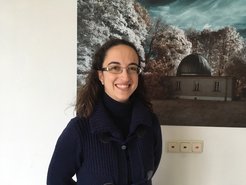Veronica Biffi
"Astrophysics is an interest more than a job"

Life
I am Veronica Biffi and I am currently a permanent researcher at INAF, the National Institute for Astrophysics in Italy, (based at the Trieste Astronomical Observatory), since January 2021. Before that I was a post-doc with a personal DFG grant at the University
Observatory in Munich (USM-LMU, 2019-2020), and there I became an eROSITA member. I got my B.Sc. in Astronomy (2006) and M.Sc. in Astrophysics (2008) at the Bologna University (Italy), and my PhD in 2012 from the LMU in Munich, where I was part of the IMPRS in Garching (at MPA/MPE). After the Doctoral degree, I held post-doc positions at Madrid University, SISSA and University of Trieste, CfA in Cambridge (MA USA), before starting as an independent DFG fellow at USM-LMU in 2019.
I am originally from Grosseto, on the southern coast of Tuscany, Italy. I’ve always been interested in science since high-school, and decided to apply this inclination to something always amazing, fascinating more than anything, the Universe! Once in astrophysics, I’ve always felt no other career would have been as interesting as this one. Nonetheless, the practical difficulties related to the academic career, I must confess, have been sometimes not easy to deal with. Always moving around allows you to grow and meet different realities, but also challenges your personal life, impacting your personal relations and family above all.
Science
My research field is cosmic structures, galaxy clusters in particular. I am interested in their formation and evolution, and I study especially their baryonic (gas) content, from a theoretical point of view. The method I employ is primarily cosmological hydrodynamical simulations, from which I also derive expected observable (thermal, dynamical and chemical) properties of clusters and synthetic X-ray observations to be compared against real data. Here comes the connection to eROSITA:

I am involved especially in works combining data analyses with predictions from the “Magneticum Pathfinder” numerical simulations. This way, in collaboration with Dr. Klaus Dolag (USM-LMU, PI of the “Magneticum Pathfinder” simulations), I contributed to a few observational papers and led a simulation paper on the eROSITA PV observations of the A3391/95 cluster pair. In particular, in the research led by Thomas Reiprich it was found that the Large Scale Structure formation in the Universe, made of gaseous filaments connected to clusters residing in the web knots, can be observed in the X rays with eROSITA. From simulations, we can predict the origin and properties of the gas in clusters and in the filamentary bridge interconnecting them. Also, we can investigate the additional structures moving towards the pair system along with filaments. This kind of study has been done for the A3391/95 eROSITA field, with the help of simulation predictions for an analog simulated system of two clusters in a similar configuration. From the simulations, following the origin and time evolution of the cluster pair and its environment, we find that the bridge gas between the pair clusters is indeed filament gas, accreted from several megaparsecs away along distinct directions almost orthogonal to those followed by the gas accreted onto the pair clusters. In the simulations, the additional groups and clusters in the largescale region indeed show signatures of motion along filamentary directions towards the knot where the cluster pair resides.
Interests
Personally, I value family and personal life, other than science. I strongly believe there should be a balance, astrophysics is an interest more than a job, but one should have more than one interest in life!
For this reason, I spend my spare time with very simple and relaxing activities, many of which not related to science. Might sound trivial, but most of all I like to read, classic literature especially, diving through books into extraordinary fictional stories. Maybe it’s not so modern, but I also like to knit! As an Italian, I love cooking and eating good food. In particular, I prefer cooking traditional recipes, from the region where I originally come from — after I spent now half of my life far from my home town, this is a way to bring it with me wherever I am. I share some of my hobbies with my husband, who’s also an Astrophysicist, and together we discuss about books, travel and play chess.
In the past, I had also the pleasure to be a planetarium and museum guide at the Science Center in Trieste. I did it for a couple of years in my spare time, and I enjoyed it tremendously!
Conclusion
What to suggest to young scientists? Difficult to say. I am not going to tell them to do their best to succeed in the academic career, but just to do their best to be satisfied with their life. There are no right choices, the variables at play are too many and sometimes different from case to case. The greatest challenge is in my opinion to achieve a permanent position (so few in science!), which is after a while necessary to reach personal stability and tranquillity to work at best on one’s own research without the anxiety of finding the next job.













